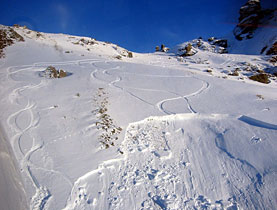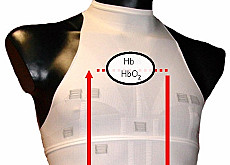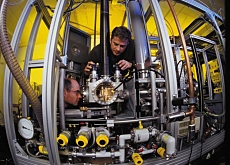Initiative aims to give boost to engineering

Nanotechnology could be soon applied to monitoring health, the environment and security on a large scale thanks to a new national initiative.
The Nano-Tera project could also provide an opportunity for engineering research and education to match the results of more traditional scientific endeavours.
Nanoscience and nanotechnology involve studying and working with matter on an infinitesimal scale. One nanometre is one-millionth of a millimetre and a single human hair is around 80,000 nanometres in width.
While there are many projects involving nanotechnology in Switzerland, the time is now right to make the next step, according to the project initiators.
“Switzerland has opportunities because it’s a technology leader,” Giovanni De Micheli, chairman of the Nano-Tera executive committee told swissinfo in Bern on Monday. “The idea is to connect the small picture with the big picture.”
Broadly speaking, the project aims to improve quality of life for the Swiss population as well as create innovative products that could provide a boost to the economy by integrating nanotechnology into so-called embedded systems.
“We want to anticipate what future products will be with this programme,” said Patrick Aebischer, president of Lausanne’s Federal Institute of Technology. The initiative also hopes to attract industrial partners at a later date with the promise of widespread use of some products.
An athlete’s or a patient’s heart could, for example, be monitored using a smart shirt that connects to a wider network and provide up-to-the-minute information to medical specialists.
Hard task
Nanotechnology has already reached a point where its practical use for monitoring can be considered. However, developing entire systems will be no small task, according to Boi Faltings, head of the artificial intelligence laboratory at the Lausanne institute.
“We will be building a large number of small devices that will generate a large amount of data,” he told swissinfo. “Some of the challenges will be about how to manage these systems, how to ensure they are reliable.”
According to Faltings, monitoring the environment with nanotechnology, for example, will provide a more accurate picture for specialists, allowing them to detect new phenomena and trends, such as how pollution affects people.
“We cannot hope to deal with disease simply by analysing genes,” he added. “Why not analyse people to see how they react to pollution? We don’t know that much so we need to collect data.”
One possibility would be to use systems developed by the project to track pandemics such as bird flu.
There are concerns though that implementing such systems could be detrimental to a person’s privacy if they are being constantly monitored. Faltings admits that this can be problem, but that it can be overcome.
“There are new technologies being developed that deal with data without revealing the source of that information,” he said. “The aim is not to identify individuals, but to answer overall questions.”
Re-injecting life
The Nano-Tera project will cost around SFr120 million ($110 million) over the next four years. One of the main goals is to re-inject some life into the once mighty engineering sector, particularly at universities.
According to De Micheli, western nations must re-evaluate their approach if they are to withstand increased competition from Asia in particular and attract the best students again.
“We would like to show that engineering is not just sitting behind a computer,” he said. “It’s about creating systems that can have an impact on society.”
swissinfo, Scott Capper
The Nano-Tera initiative will cost approximately SFr120 million over the next four years.
SFr40 million will be drawn from the funding of the Federal Institutes of Technology, while another SFr20 million will come from the Swiss University Conference.
Projects accepted to participate in Nano-Tera will also have to be supported from their home institutions, either in cash or in kind.
So far, the two Federal Institutes of Technology in Lausanne and Zurich have signed on, as well as the universities of Neuchâtel, Basel and Lugano, and the Swiss Center for Electronics and Microtechnology.
Real-time detection of different health risks and conditions.
Revealing security risks through smart buildings and environments.
Saving energy through ambient sensing (automatically switching off the television when a person leaves the room for example).
Detecting and monitoring environmental hazards such as floods and avalanches from space or hard-to-reach positions on Earth.

In compliance with the JTI standards
More: SWI swissinfo.ch certified by the Journalism Trust Initiative



You can find an overview of ongoing debates with our journalists here . Please join us!
If you want to start a conversation about a topic raised in this article or want to report factual errors, email us at english@swissinfo.ch.